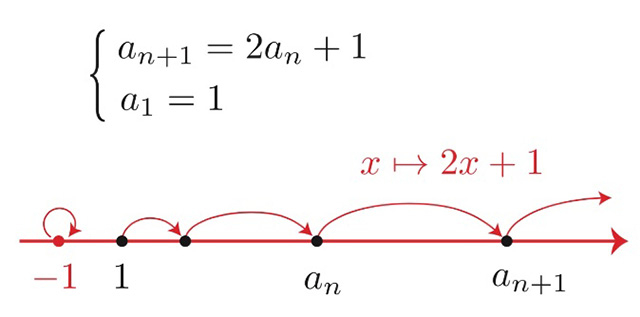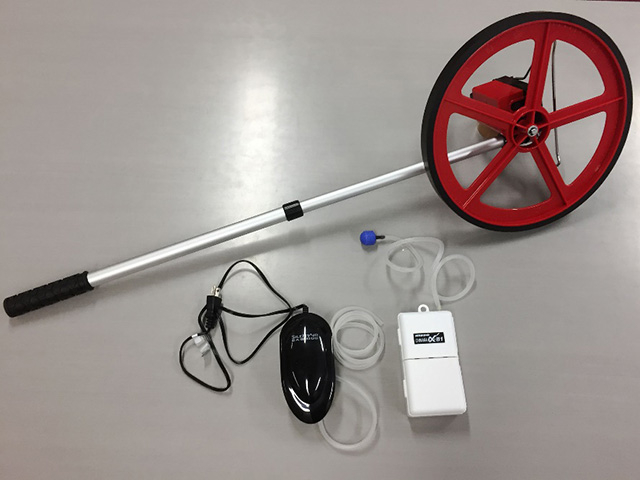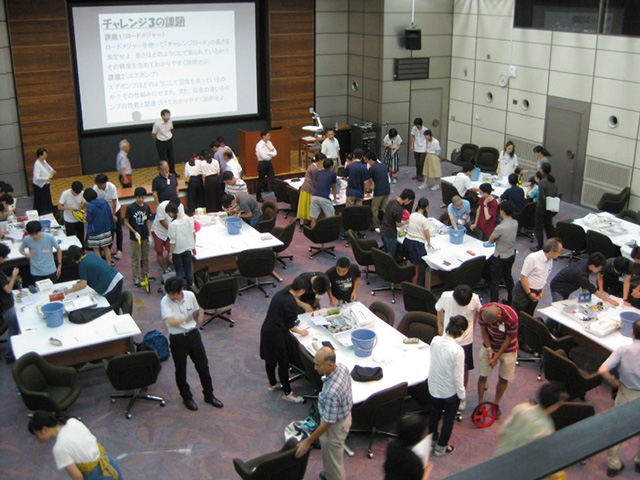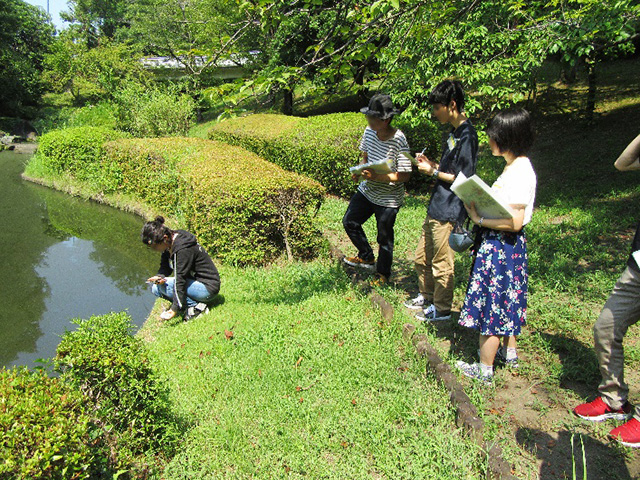15th annual Tokyo Tech summer camp for high school students
Tokyo Tech's Summer Challenge, a unique three-day-two-night camp for high school students, provides youngsters the chance to participate in university-level education while engaging with some of the world's researchers. Despite the record-breaking heat, the event was again held in the summer of 2018, marking the 15th anniversary of the camp.
From August 1 to 3, 91 participants gathered in the now-familiar Ranzan Town in Saitama Prefecture to exercise their creativity and teamwork skills, motivate each other to discover new fields of interest, and build lasting new relationships. While the number of participants was lower than last year, the 2018 event offered those present with more time and space to explore new frontiers. This year, Provost and Executive Vice President for Institute Strategy Isao Satoh and Executive Vice President for Education Tetsuya Mizumoto joined to spark the interest of Japan's future science and technology leaders.
As in past years, students were presented with a diverse mix of seven intellectual challenges.
Outline of Summer Challenge 2018
- Dates: August 1 to 3, 2018
- Place: National Women's Education Center of Japan in Ranzan Town, Saitama Prefecture
- Number of participating students: 51
- Tokyo Tech High School of Science And Technology: 34
- Ochanomizu University Senior High School: 7
- Tokyo Gakugei University Senior High School: 10
- Tokyo Tech faculty: 25
- High school teachers: 9 (from 3 schools)
- Tokyo Tech administrative staff : 6
- Total number of participants: 91
Challenges 1: Column Land
Professor Kyoko Yamamuro
Department of Industrial Engineering and Economics, School of Engineering
Summer Challenge 2018 kicked off with Column Land, a popular Tokyo Tech class and effective icebreaker where students evaluate short anonymous pieces of writing prepared in advance by all participants. This year's topic was water, a fitting antidote to the scorching weather. The diversity and creativity of the participants was evident in the submissions, which included hidden messages, palindromic passages, and other original texts. This year's winner was a humorous letter written by "water" to a human recipient.
The style is the man himself, according to the proverb. By critiquing each other's writing, students quickly acquainted themselves with others while appreciating different styles and personalities.
High school teacher's comment:
An ideal icebreaker that gets the brain working. This challenge provided a great way for our students to get to know students from the other high schools.
Challenges 2: The worlds where series dwell — From recurrence relations to dynamic systems —
Associate Professor Tomoki Kawahira
Department of Mathematics, School of Science

Challenges 2
After some linguistics, it was time for math. Challenge 2 familiarized students with recurrence relations. Like an endless railroad, a number series keeps on going, but a formula can tell us what the next number in the sequence is. If an+1 can be expressed as a form of an, we can determine a number series, something that students have seen in recurrence formula questions in their textbooks (right figure). But now, let us add some philosophy.
"So x = 2x+1 right, but what does it mean?"
"Wait, what do you mean what does it mean?"
By obtaining the solution for x, students had been able to discover a clear recurrence formula, but many of them had not even considered the possibility of a deeper meaning.
"Imagine we place this series on a straight line, and then a ‘higher power’ suddenly orders the numbers to move to specific positions one second later. One interpretation is that the number series is now obeying the laws of motion in this world — the world of dynamical systems. This equation is not only expressing motion in one world, in a way it is seeking the center of the universe."
Challenge 2 invited students not only to define a number series mathematically, but also added another dimension that linked math to the tangible world.
High school teacher's comment:
This useful challenge dug deeper than simply learning the method, as is often the case in high school, and showed how mathematics is connected to advanced fields of science and technology.
Challenges 3 & 4: Elucidating mechanisms — Disassembling surveyor's wheels and air pumps
Associate Professor Mitsutoshi Ueda
Department of Materials Science and Engineering, School of Materials and Chemical Technology
The legendary disassembly challenge was back this year, and the first item to take apart was a 1-meter surveyor's wheel. Often used to measure distance in environments such as athletics events, the accuracy of the device was put to the test by measuring the length of a course that included curves. After confirming the error range with several trials, the tool was disassembled. Groups examined the numerous parts making up the wheel, and confirmed how components move as the device is reset.
The second disassembly challenge involved air pumps that supply air to an aquarium — a portable battery-powered one and a stationary one connected to a power supply. In addition to examining the mechanisms, students were also able to experiment with the devices to compare performance.
Challenges 3 and 4 ended on Day 2, during which teams had to put their group work and time management skills to the test by presenting their findings on one of the two devices.

Measuring wheel and air pump ready for disassembly

Disassembly and analysis challenge
High school teacher's comment:
All the students seemed very interested, but due to the nature of this challenge, I quickly recognized the students with a true passion for science and technology, as they could not keep their hands off the props. This is something I would not have noticed during a regular classroom lecture.
Challenges 5: Polymers and Medical Care — What materials are active in our bodies?
Professor Takeshi Serizawa
Department of Chemical Science and Engineering, School of Materials and Chemical Technology
Following the materials-focused challenge on Day 2, Professor Serizawa's talk was a natural continuation of the previous analysis task.
Polymers are special in that they are easily moldable and light, making them useful "assistants" that can support the human body in case of trouble. Students were asked to discuss in groups a concrete example — the artificial hip joint. They were then asked to brainstorm which of the three main materials — hard metals, wear-resistant inorganic materials, or moldable polymers — were best suited to replace damaged body parts. And, if they had the chance to create an artificial hip joint from polymers for a human who takes thousands of steps every day, how should it be done?
The groups suddenly got serious as they had been given a concrete goal that, if achieved, could help human beings. A walk around the room revealed that many students were discussing the use of gel. The use of a biomimetic gel would be ideal. By growing "a lawn" of synthetic polymers, only a few submicrons long, that fuse together through covalent bonding and blend agreeably with water, friction could be reduced.
High school teacher's comment:
There were hints concerning the essence of the topic throughout the lecture, making it an interesting way to gauge students' ability to obtain information. Afterwards, many students approached the professor with questions, demonstrating their interest in medical treatment.
Challenges 6: The nature of sound — Physics of sound and human hearing
Professor Kentaro Nakamura
Laboratory for Future Interdisciplinary Research of Science and Technology, Institute of Innovative Research
Sound is transmitted when air molecules move or vibrate. The magnitude of sound is expressed through sound pressure. The faintest sound a human can hear is about 0.00002 pascals (Pa), while the sound of a jet engine 50 m away is about 20 Pa. This range is so wide, however, that using decibels (dB) instead is much more practical.
The highs and lows of sound are expressed in frequency, or Hertz (Hz). Again, the range of the human ear is vast. We can hear low sounds down to about 20 Hz, and high sounds up to about 20,000 Hz. The sensitivity of the ear changes with frequency, which is why low sounds appear softer.
After learning the fundamentals of sound, student groups tried to answer one of three questions. Most groups chose the following: If humans only have ears on the left and right sides of the head, how can we distinguish the sound sources located in front of us and behind us? To shed light on the topic, participants were asked to close their eyes, block one ear, turn around randomly, and then listen to sounds let out around the room.
The truth is this question has yet to be fully answered, which aroused the spirit of inquiry in many students.
High school teacher's comment:
The professor explained sound waves, which can be difficult to grasp, with various videos and other materials, which helped students to understand the topic more clearly. The interesting content also demonstrated the allure of research and the fact that there rarely is one single answer to a question.
Challenges 7: The air around us — Examining indoor air quality
Associate Professor Naoki Kagi
Department of Architecture and Building Engineering, School of Environment and Society

Measuring PM2.5 concentration at Japanese garden
The final challenge was a special one related to architecture. This field involves everything from designing buildings and ensuring their seismic performance with a certain type of structure to pleasing the human eye, but it also involves air. Air is more important to take in than food, and whether it is clean or contaminated has a direct effect on our health. Most of us spend approximately 80 percent of the day inside a building, so indoor air quality is extremely important.
After acquiring some fundamental knowledge, it was time for the students to experiment by measuring fine particles (PM2.5) in the air. Each group was given a handy PM2.5 sensor to measure concentrations from various parts of the room, outside the building, in the garden, and near the road.
The cleanest air was just at the outlet of the air conditioning supply, which was even cleaner than that at the front of the air purifiers. When stepping outside into the "fresh air," students were surprised to learn that PM2.5 values shot up. Buildings actually protect us from various indoor environment contaminants.
High school teacher's comment:
Activities that involve leaving the lab are an effective way to connect learning with real life. I think even if the overall program has one less challenge for the students, dedicating time to this kind of task is important.
. Any information published on this site will be valid in relation to Science Tokyo.






